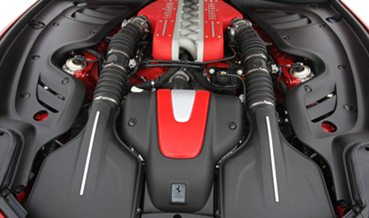2012 Ferrari FF - Driving Impressions
Ever drive a Ferrari on top of a mountain? In the snow? The fact that the Italian sports car maker flew its 2012 Ferrari FF to the top of a ski slope in the Dolomites is proof positive that this is not an ordinary exotic. The FF is the first production Ferrari to offer all-wheel drive and is a 2+2 with a difference in that its body style is more of a shooting brake (think 3-door wagon) than a traditional GT.
Dimensionally, the FF has about the same footprint as the 612 Scaglietti it replaces. Riding on a 117.7-in. wheelbase, the FF measures 193.2 in. overall and stands 54.3 in. tall and 73 in. wide.
The design is somewhat akin to the old BMW M Coupe, with a long hood and extended roof that ends in a Kamm-back style hatch. The nose features a large smiling opening with the traditional Ferrari eggcrate grille, along with headlamps that feature projector beams and LEDs, a la the 458 Italia. The side has flowing character lines, a vent on the front fenders and at the rear, and prominent aero devices such as a lower wing and diffuser. What the shape lacks in traditional Ferrari sexiness, it makes up in attention to detail, both inside and out. It truly is a car that looks better in person than in photographs.
Among those neat details is the way the fenders are curved over the rear-round taillamps, which are flanked by mesh grillwork. Inside, the seats are aggressively bolstered and feature the expected fine leather upholstery. All necessary controls, from the engine start button to the 5-position manettino, are positioned on the steering wheel (which also includes buttons for the turn signals—it takes a little getting used to, but effective in operation).
The instruments are traditional analog gauges and the center console features a 6.5-in. touch-screen for entertainment and navigation, although the system’s interface on the nav (and its operation) could use a significant upgrade. It’s similar to the system that is found on the California—it’s still not easy to use, and the accuracy is lacking compared to that of other luxury vehicles.
First Production All-Wheel-Drive Ferrari
The 6.3-liter direct-injected V-12-powered FF puts its 651 horsepower to the pavement via a unique drive system that basically has two transmissions. At the rear is a 7-speed dual-clutch gearbox similar to the one used on the California. A second smaller gearbox attached to the front of the engine, which is positioned aft the front axle centerline, has two gear ranges that cover the same ratios as 2nd and 4th gear of the main box and is used, via wet clutches, to drive the front wheels when there is reduced grip.
This arrangement does two important things—because it is separate from the rear gearbox, there is no need for a center differential and dual driveshafts. The Ferrari system is lighter and more efficient thanks to reduced parasitic losses. This also allows the FF to have the advantages of all-wheel drive while having a front/rear weight distribution of 47/53 percent.
To best display the subtleties of this system, Ferrari built a special snow-bound test track on the top of the mountain in Brunico. Taking a few hot laps reveals that the FF is surefooted when the ice/snow mode is selected on the manettino. Move the switch to Wet, and you still gain the benefit of the all-wheel-drive bite, but each step through Comfort and Sport allows the rear end to step out.
Unlike other stability control or all-wheel-drive systems—which look for grip by reducing torque, braking individual wheels or shifting power to the tire with the most traction—the FF system actually adds power to the front wheels to help pull the car through the corners. Most of the time, with individual wheel braking or cutting torque, you can feel the weight transfer. The FF avoids any sense of this, as the added power to the front wheels corrects the understeer.
The 2012 Ferrari FF, despite its larger passenger cabin, is still a quick, nimble GT that has lost none of alacrity of the 612. The factory reports that 0-100 km/h (62 mph) comes up in 3.7 sec. and that the car tops out at 208 mph. Out on the road, the FF feels quick, composed and drives much smaller than its size. It’s very easy to forget the two rear seating positions and hatchback design when hustling the car on twisty mountain roads. The dual-clutch transmission provides snappy up and downshifts, and does an admirable job of quickly learning your driving style. When I breathed off the throttle and gently braked to settle the car, the transmission would immediate downshift, announced by a throaty blat from the exhaust.
Mechanically, the FF, with its innovative approach to on-demand all-wheel-drive, is everything you would expect from Ferrari. Should Ferrari have built such an all-season GT entry? It’s a debate that will go on in Ferrari circles for some time. Purists will argue against it. But it’s basically a moot point—with only 800 available worldwide during the first year at a cost approaching $300,000, the FF is basically sold out. Its long-term value will be left for future Ferraristi to decide.
Post: Tram Nguyen


















++(3).jpg)
